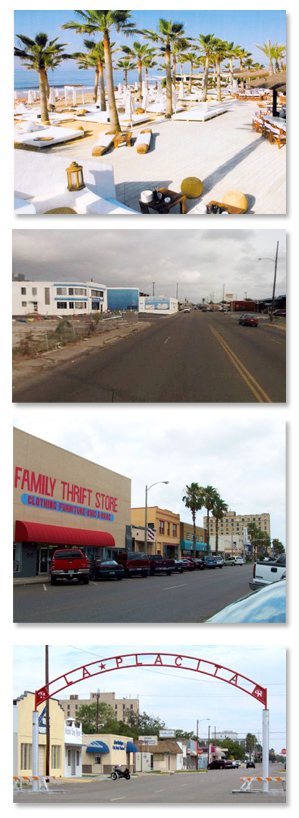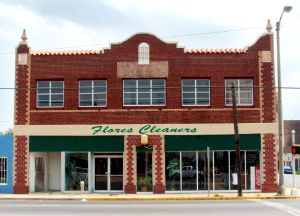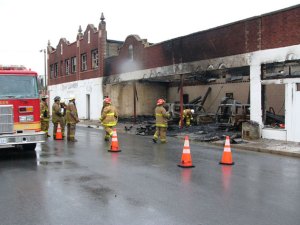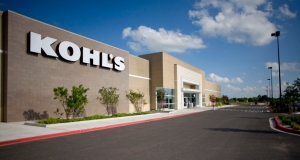
Kohl's in Harlingen
At the heart of Harlingen’s retail district, Dixieland Road brings in most of the incoming, southbound traffic from Expressway 83. Lincoln Avenue funnels traffic in from north/west bound traffic coming in from Expressway 77. Dixieland, Lincoln and the highways form major arteries surrounding Valle Vista Mall and its neighboring commercial developments.
Since the 1980s, much of Harlingen’s retail sector has called the Dixieland Corridor home. In addition to Simon-owned Valle Vista Mall and well-established big-box retailers Target, Walmart, and HEB, the district has seen the development of Lincoln Corners in the early 2000s and Harlingen Corners within the last two years. These projects have brought retailers such as PetSmart, Hobby Lobby, Ross, Kohls and Marshalls to the area, as well as restaurants like IHOP, Logan’s Road House and Chick-Fil-A.
In early 2006, then-mayor Rick Rodriguez announced the expansion of one of Harlingen’s busiest commercial thoroughfares, Dixieland Road.
“Once completed, the opportunities for commercial and retail development along this corridor are endless.”
Harlingen Mayor Rick Rodriguez, Valley Morning Star, Feb. 3, 2006
Project Scope
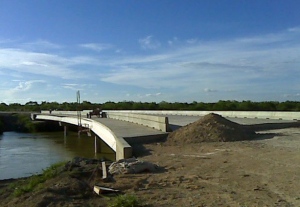
Dixieland Bridge by Sergio Chapa
TXDoT engineers say the project will extend Dixieland Road from Garrett Road south to the intersection of Rangerville Road and Thieme Road. The road will be expanded to four lanes, and the 2.87-mile stretch of road will include a bridge over the Arroyo Colorado.
Why it Should Happen
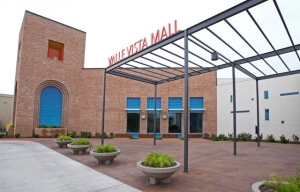
Valle Vista Mall - Renovation by Megamorphosis Design of Harlingen
1. Valle Vista Mall — While some of Harlingen’s most successful retail venues are located within the Dixieland area, it’s no secret that Valle Vista Mall is the elephant in the room. The mall has lost its luster. Once known as a premier shopping destination in the Rio Grande Valley, over time Valle Vista has lost anchor tenants (mostly through the failure of the company, not because of low performance, i.e. Circuit City, Steve & Barry’s and Mervyn’s). The mall has also failed to attract many retailers that are considered mall staples — The Gap, Abercrombie & Fitch, Banana Republic. Despite a heavy renovation that modernized the facility, Valle Vista remains a low priority for the mall’s owner, Simon Properties. While it may not be THE destination it once was, Valle Vista Mall is the most visible. It is the retail nucleus within the Dixieland Corridor.
2. Traffic — Currently, all of the traffic in the business district is funneled in from the northern portion of Dixieland Road and West Lincoln Ave. It’s a rare occasion to find a lull in traffic to make that left turn from the Target parking lot onto Dixieland, or enter Lincoln Ave from any of Walmart’s exits. Access to the area from other points would greatly reduce the amount of congestion on the main thoroughfares.
3. Future Development — Harlingen’s retail sector was dealt a heavy blow when Simon opened the close-by shopping mecca RGV Premium Outlets. Before the outlet’s construction, Harlingen was finally starting to add an impressive lineup to its dwindling shopping venues. Anchored by Kohl’s and Bed, Bath & Beyond, the Harlingen Corners development was designed to be a “shot in the arm” for Harlingen’s retail sector. It was meant to offset the tax dollar drain that would inevitably follow the construction of the outlet mall in Mercedes. However, the recent breakdown of the US economy caused many retailers and restaurants to back out. Old Navy, McAlister’s Deli, Cracker Barrel, Best Buy and a major bookstore all pulled out of the Harlingen Corners development.
Still, Harlingen’s Dixieland Corridor is probably the most ideal location for continued retail growth. Being “at the crossroads” — the point where US 83 and 77 converge, the Dixieland Corridor is constantly in the spotlight. It would be wise to continue exploring all possible venues for attracting business to the district.
Growth Potential

Bass Pro Shop
Being in the spotlight has its privileges, and Harlingen’s powers-that-be (city leaders, investors, and the wealthy — often all the same group of people) have seen to it that retail growth is concentrated in this area. The rest of us, whether we like it or not, have to grin and bear it. There are those of us who believe there have been many dealings where a land sale has resulted in a public official lining his pockets with extra cash. Is it despicable? Definitely. But it’s happened. We can fight it through lawsuits and complaints, but ultimately we have to accept it. After all, it has improved our own shopping options, and it helps keep tax dollars within the city. And that means more money for public projects — something the city of Harlingen needs desperately.
The Dixieland Corridor has its merits. Several years ago, the city initiated the development of three Tax Increment Finance (TIF) Zones. One of these, known as TIF Zone #3, was established in the Spur 54 area adjacent to Dixieland Road. The Harlingen Corners development occurred through this designation, and plans for the future Cameron Crossing development are underway. Cameron Crossing will be home to Harlingen’s biggest retail development yet — Bass Pro Shops.
Despite the rumored costs of $40M to as much as $60M going to the Harlingen taxpayers for Bass Pro, there is nothing on-record to suggest incentives will be that high. City officials have stated that they plan to issue tax revenue bonds for $26M – $28M for the construction of the 130,000 square foot store. Tax revenue bonds are secured by the proceeds of a specific tax, in this case a half cent sales tax that has already been allocated for economic development in Harlingen. This tax rate cannot be raised if it becomes insufficient to pay the bonds. While the Economic Development Corporation of Harlingen will own the building itself, Bass Pro Shops will pay the city rent, which will also help retire this debt. Many people are up in arms at the thought of the city plunging into debt. But when it is completed, Cameron Crossing, an 89-acre, 850,000-square foot development, will eventually include a hotel, restaurants and other retail sites. Tourists from throughout the Valley, Mexico, and all points south of San Antonio will be injecting much needed tax dollars into the city, not to mention patrons from Harlingen as well.
With the addition of a mega retail shopping destination like Cameron Crossing to the Dixieland Corridor, would Simon Properties be poised to reinvent the Valle Vista Mall development? This one is straight from the rumor mill…

San Marcos, Texas Hotel and Conference Center
For the past two years, executive sessions called during the city commission meetings have included discussions on “Project Room.” While the city has taken no action on this project, it has been reported on various sites that the project calls for the development of a high-rise hotel and convention center. According to the rumor, R&G Capital LLC, led by Rene Garza of Houston and Gene Dennis of Corpus Christi and McAllen, are planning on adding the hotel and convention center to the Valle Vista Mall property. Apparently, Simon has “given its blessing.” However, the group is asking the City of Harlingen for $12M to help construct the $30M development. The group previously sought the development of a $70M soccer complex, water park and convention center in Brownsville. The project did not materialize.
Reports suggest the convention center would be suited for 800 people, and the entire development would adjoin the mall. It has been noted that the size of the proposed convention center is too small, and that if it does connect to the mall, a large portion of the parking would be built over. That implies that a parking structure may need to be constructed as well. Many agree that if Simon is willing to allow the development, it should also be prepared to foot the bill. The city has already given incentives to failed retailers at Valle Vista (i.e. Steve & Barry’s), and with the public already fearing the impending debt from Bass Pro, it may be wise for the city to allow the developers to see this one through on their own. Indeed, the city commission has yet to take any action on this agenda item.
That said, if completed, the Project Room development could potentially change Harlingen’s status within the Rio Grande Valley. A convention center could offer a viable venue for musical entertainment and business conferences. A high-end hotel could help keep tourists in town during peak travel seasons, regional sporting events and local conventions. It is widely known that convention centers are not money-makers. However, it is an opportunity to employ many and attract visitors from out of town.
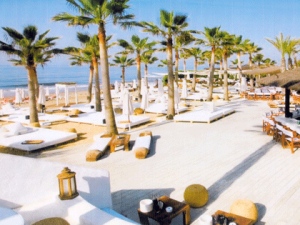
Dixieland Beach Club Rendering
While the major retail developments may be front and center, in the limelight, near expressway frontage, still one more potential development has captured the attention of Harlingen residents. This past April, Harlingen businessman Humberto Zamora presented a project to the Harlingen City Commission called the “Dixieland Beach Club.” Zamora is known for his grandiose business schemes, and especially how quickly they fizzle out. In April 2008, Zamora aimed to develop the Jackson Street Music Conservation/Preservation Hall. The music venue was never completed and the dilapidated buildings currently sit empty, for sale on Harlingen’s historic Jackson Street.
Zamora plans to convert Dixieland Park, located just south of the Harlingen High School South campus and the River Oaks subdivision. For years, Dixieland Park was known as a haven for sexual conduct and drug usage, but has since been rejuvenated. The park has a public pavilion that can be rented for events and a Disc Golf course for Frisbee enthusiasts. The Dixieland Beach Club project would be an investment of $1.5M — not from the city, but from Zamora’s own pockets. His vision is for a resort-style sand beach with cabanas and a boardwalk overlooking the Harlingen Reservoir. Because the water is used as drinking water for the city, swimming would continue to be prohibited, but fishing would be allowed as it is currently.
The pictures in the presentation packet that he distributed to commissioners appeared to be those of a luxurious Caribbean or Mediterranean resort.
He said he would make a profit by charging for beach chair rentals, banquet space at the club’s concessions stand pavilion and serving a “specialized menu of seafood and steak.”
-Valley Morning Star, April 26, 2010
Without a doubt, Harlingen’s image would definitely benefit from having a water or beach-front feature. But many believe with South Padre Island only a few miles away, the park would be useless, especially since swimming would be prohibited. The idea may not have been completely thought out, but it does raise hope that Harlingen has a lot more potential than many people give it credit for. Perhaps the addition of a lazy river surrounding the reservoir would give sunbathers the added bonus of being able to float along the park in inner tubes, enjoying a resort-like atmosphere. If not Zamora’s vision of the Dixieland Beach Club, then perhaps the park could be redeveloped to appear as a lush garden and water feature. How about erecting a modern art museum on the banks of the reservoir? How about an observatory? There are countless possibilities for Dixieland Park. And while the Dixieland Beach Club may not be the best use of the space, at least we are able to look at it in a new light.
With the expansion of Dixieland Road, one thing is certain — traffic will begin to flow through a part of Harlingen that has largely been ignored. This will open our eyes to the potential development that can bolster our city’s image, increase options for entertainment, retail and business, and help Harlingen regain a spot in the Rio Grande Valley’s top three.
Sources:
Valley Morning Star — September 16, 2006; June 06, 2007; April 22, 2008; April 26, 2010
The Brownsville Herald — July 7, 2008
The Monitor — May 6, 2010
The RGV Forum
MyLeaderNews.com







